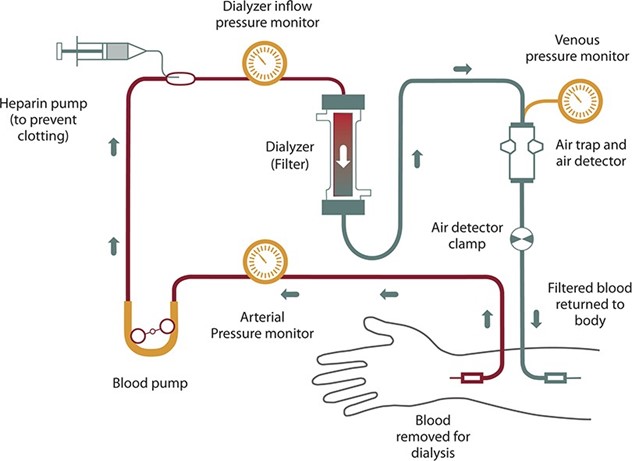A nurse is reviewing the laboratory data of a client following a hemodialysis treatment. The nurse should expect to find a decrease in which of the following laboratory values?
Calcium
Potassium
Protein
RBC count
The Correct Answer is B
Choice a) is incorrect because calcium levels are not directly affected by hemodialysis. Calcium is a mineral that is important for bone health, blood clotting, and muscle contraction. Hemodialysis does not remove calcium from the blood, but it may cause low calcium levels if the dialysate fluid has a lower concentration of calcium than the blood.
Choice b) is correct because potassium levels are decreased by hemodialysis. Potassium is an electrolyte that is essential for nerve and muscle function, especially the heart. Hemodialysis removes excess potassium from the blood, which can build up in people with kidney failure and cause irregular heartbeats, muscle weakness, or even cardiac arrest.
Choice c) is incorrect because protein levels are not decreased by hemodialysis. Protein is a macromolecule that is composed of amino acids and performs various functions in the body, such as building and repairing tissues, transporting substances, and regulating processes. Hemodialysis does not remove protein from the blood, but it may cause low protein levels if the client has a poor diet or loses protein through other means, such as urine or wounds.
Choice d) is incorrect because RBC count is not decreased by hemodialysis. RBCs are red blood cells that carry oxygen throughout the body. Hemodialysis does not remove RBCs from the blood, but it may cause low RBC count if the client has anemia, which is a common complication of kidney failure. Anemia can be caused by reduced production of erythropoietin (a hormone that stimulates RBC production), iron deficiency, or blood loss.

Nursing Test Bank
Naxlex Comprehensive Predictor Exams
Related Questions
Correct Answer is C
Explanation
Choice A Reason: This is incorrect because dabigatran does not affect the electrical activity of the heart or the conduction system. It does not slow down the ventricular response to the atrial impulses.
Choice B Reason: This is incorrect because dabigatran does not dissolve existing clots in the bloodstream. It only prevents new clots from forming.
Choice C Reason: This is correct because dabigatran reduces the risk of stroke in clients who have atrial fibrillation by preventing clot formation and reducing blood viscosity. Dabigatran is an anticoagulant medication that prevents the formation of blood clots in the heart and blood vessels. Atrial fibrillation is a condition where the atria beat irregularly and rapidly, which can cause blood to pool and clot in the heart chambers. These clots can travel to the brain and cause a stroke. Dabigatran reduces the risk of stroke by preventing clot formation and reducing blood viscosity.
Choice D Reason: This is incorrect because dabigatran does not restore normal sinus rhythm in clients who have atrial fibrillation. It does not affect the heart rate or rhythm.
Correct Answer is C
Explanation
Choice a) is incorrect because morphine sulfate is an appropriate prescription for a client who has acute heart failure following MI. Morphine sulfate is an opioid analgesic that can relieve pain, anxiety, and dyspnea. Morphine sulfate can also reduce the preload and afterload of the heart, which can improve the cardiac output and oxygenation.
Choice b) is incorrect because laboratory testing of serum potassium is an appropriate prescription for a client who has acute heart failure following MI. Serum potassium is an electrolyte that is important for the normal function of the cardiac cells and muscles. Serum potassium can be altered by various factors, such as renal function, acid-base balance, medications, or dietary intake. Serum potassium can affect the cardiac rhythm and contractility, which can influence the outcome of the client.
Choice c) is correct because 0.9% normal saline IV at 50 mL/hr continuous is a prescription that requires clarification for a client who has acute heart failure following MI. 0.9% normal saline is an isotonic solution that can maintain the fluid balance and blood pressure in the body. However, 0.9% normal saline can also cause fluid overload and worsen the heart failure symptoms, such as edema, crackles, and dyspnea. The nurse should clarify with the provider if this prescription is appropriate for the client's condition and if there are any parameters or limits for the fluid administration.
Choice d) is incorrect because bumetanide 1 mg IV bolus every 12 hr is an appropriate prescription for a client who has acute heart failure following MI. Bumetanide is a loop diuretic that can increase the urine output and reduce the fluid volume and pressure in the body. Bumetanide can also decrease the preload and afterload of the heart, which can improve the cardiac output and oxygenation.
Whether you are a student looking to ace your exams or a practicing nurse seeking to enhance your expertise , our nursing education contents will empower you with the confidence and competence to make a difference in the lives of patients and become a respected leader in the healthcare field.
Visit Naxlex, invest in your future and unlock endless possibilities with our unparalleled nursing education contents today
Report Wrong Answer on the Current Question
Do you disagree with the answer? If yes, what is your expected answer? Explain.
Kindly be descriptive with the issue you are facing.
